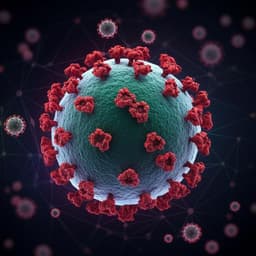
Medicine and Health
Social markers of a pandemic: modeling the association between cultural norms and COVID-19 spread data
M. Kapitány-fövény and M. Sulyok
This compelling study by Máté Kapitány-Fövény and Mihály Sulyok explores how social norms influence the spread of COVID-19. By identifying societal groups and examining factors like population density and freedom of assembly, they shed light on the unexpected relationship between climate and infection rates. Discover the surprising dynamics that shape COVID-19 transmission.
~3 min • Beginner • English
Introduction
The study addresses why countries exhibited markedly different early COVID-19 epidemic curves and investigates which social markers—particularly cultural norms around autonomy, compliance, social capital, and freedoms—are associated with transmission speed. It contrasts governmental policy stringency with population responses, asking whether willingness to suspend freedoms, discipline/compliance, sociability and network density, civic participation, and accustomed freedom of assembly/association shape national outbreak dynamics. Prior models emphasized policy stringency, travel restrictions, and infectious period; however, public attitudes are heavily influenced by media and governmental communication. The authors aim to identify social characteristics associated with the doubling rate of reported COVID-19 cases while controlling for climate, demographics (population size and density), governance and policy stringency, testing rates, healthcare access and quality, preventative interventions, GDP per capita, and travel/tourism contribution to GDP.
Literature Review
Empirical work on past pandemics (H1N1, zoonoses, tuberculosis, airborne pathogens) links low education, non-Caucasian ethnicity, overcrowding, neighborhood deprivation, individualistic values, and poor socio-environmental conditions with increased hospitalization, point-source epidemics, or higher outbreak counts (Mayoral et al., 2013; Lowcock et al., 2012; Morand & Walther, 2018; Issarow et al., 2018). The literature suggests individualism is associated with more infectious disease outbreaks and that collectivist cultures—often in hotter regions—may confer protection against pathogen transmission (Fincher et al., 2008). However, few studies directly assessed social capital and perceived importance of personal freedom in relation to virus spread during periods of extreme restrictions. The authors therefore leverage contemporary, broad social indicators (Legatum Prosperity Index 2019; WVS Wave 6) instead of older collectivism metrics (e.g., Hofstede).
Methodology
Design and data sources: A global, country-level ecological study focusing on the initial outbreak phase (71 days from 23 Jan 2020 to 27 Mar 2020). COVID-19 incidence data were obtained from JHU CSSE (accessed 28 Mar 2020). Doubling times were derived from log-linear models of incidence; for China and South Korea, only the early increasing phase was included.
Variable selection principles: relevance (global coverage, nationally representative social markers or global indicators), recency (as close as possible to the outbreak, with exceptions justified), and repeatability/reproducibility (preferably annually updated sources). Some less recent but relevant datasets were included (WVS 2010–2014; HAQ index 2015; 2018 travel & tourism GDP share).
Covariates: Social norms/cultural values from Legatum Prosperity Index 2019 (government effectiveness; agency; freedom of assembly and association; social networks; personal and family relationships; civic and social participation; preventative interventions), WVS Wave 6 items (social utility, conformity, trust in government, obedience to rulers), and additional national indicators (population size and density from GeoNames; GDP per capita; healthcare access and quality index—HAQ 2015; travel & tourism direct GDP contribution 2018; climate zone per updated Köppen–Geiger classification via Kottek et al., 2006; Rubel et al., 2017). Government Stringency Index (Oxford) and COVID-19 tests per million (Our World in Data) were available but had many missing values.
Clustering analysis: Model-based clustering on scaled data for 87 countries using mclust (Gaussian finite mixture models; EM initialized by hierarchical clustering; model chosen via BIC). Variables with high missingness (tests per million, WVS items, Government Stringency Index) and the categorical climate zone were excluded from clustering.
Predictive analysis: Random forest regression (randomForestSRC) predicting doubling time on the same observations. Continuous variables were log-transformed. Nodesize and mtry tuned to minimize out-of-bag (OOB) error. Forest comprised 100 trees; sampling without replacement (swor); all variables included. Variable importance assessed via minimal depth and permutation VIMP; partial dependence/variable dependence examined. All analyses conducted in R 3.6.1; custom script provided as supplementary material.
Key Findings
- Clustering yielded four societal types with distinct profiles:
• Cluster 1 – Reserved: High population, lower density; low government effectiveness, GDP per capita, and HAQ; dry climates; lower agency and freedom of assembly/association; relatively higher doubling times; lower testing; moderate-high stringency. Examples: Iran, Pakistan, Egypt, Algeria, Kazakhstan, Mexico. Higher trust in government and valuation of obeying rulers compared to Clusters 2–3.
• Cluster 2 – Drifting: Temperate climates; low population and density; higher government effectiveness; moderate freedom of assembly/association and agency; lower civic/social participation; lower GDP and HAQ than Cluster 3; high stringency; lower testing than Clusters 3–4; shorter doubling times. Examples: Czechia, Greece, Italy, Hungary, Slovenia, Slovakia, Peru, Estonia, Poland.
• Cluster 3 – Assertive: Temperate climates; highest government effectiveness, GDP per capita, HAQ; strong social networks and personal/family relations; high freedom of assembly/association; lowest government stringency; high testing; lowest doubling times. Examples: Australia, USA, UK, Germany, Sweden, Spain, Switzerland, France. Highest importance placed on doing good for society and behaving properly, but lower trust in government and low importance of obeying rulers.
• Cluster 4 – Compliant: Dry climates; high population density; lower social networks and personal/family relationships; lower freedom of assembly/association; HAQ and GDP per capita high but below Cluster 3; highest testing and highest stringency; highest doubling times (i.e., slowest spread), despite high density. Examples: South Korea, China, UAE, Israel, India, Singapore. Highest confidence in government; higher conformity towards government and others.
- Random forest model performance: OOB error ≈ 0.25.
- Top predictors of doubling time (importance by minimal depth and VIMP):
• Population density (MD 2.07; VIMP 0.0318) – overall positive association with doubling time.
• Freedom of assembly and association (MD 2.61; VIMP 0.0146) – overall negative association with doubling time.
• Agency (MD 2.68; VIMP 0.034) – overall negative association with doubling time.
• Climate class showed high VIMP (0.03) but high MD (3.73).
- Additional associations: GDP per capita and temperate climate (class C) showed positive associations with doubling time; greater freedom of assembly/association and agency associated with shorter doubling times (faster spread).
Discussion
Findings suggest that social norms strongly shape early COVID-19 transmission dynamics beyond traditional structural factors (GDP, healthcare quality, government effectiveness). In particular, greater accustomed freedom of assembly/association and individual agency correlate with faster transmission (shorter doubling times), likely reflecting challenges in adapting to stringent movement and gathering restrictions and, in some cases, lower policy stringency. Conversely, societies characterized by regulatory compliance and lower emphasis on public assembly rights exhibited slower spread even at high densities (e.g., Cluster 4). Results align with theories linking collectivism and pathogen prevalence, though the study relies on contemporary social indicators instead of classic collectivism metrics. Public health implications include prioritizing strategies to influence attitudes and behavior, balancing human rights with effective mitigation, and considering cultural receptivity to paternalistic vs. libertarian approaches in crisis communication. The population’s interpretation of risk and acceptance of temporary restrictions may be pivotal in shaping epidemic trajectories.
Conclusion
The study introduces a cross-national cluster typology linking social norms to early COVID-19 spread and identifies key social predictors—population density, freedom of assembly/association, and agency—of doubling time. Compliant societies in dry climates achieved the longest doubling times despite high densities, underscoring the role of regulatory compliance and social norms. These insights highlight the need to integrate social factors into infectious disease forecasting and policy planning. Future research should: validate and replicate the cluster typology on other pathogens and timeframes; reassess with updated social datasets (e.g., WVS Wave 7); explore causal pathways between social freedoms, compliance, and adherence; and examine how communication strategies can maintain human rights while achieving effective mitigation.
Limitations
- Use of some non-contemporaneous covariates (WVS 2010–2014; HAQ 2015; travel & tourism 2018) may reduce temporal alignment with the 2020 outbreak.
- Variables with high missingness (testing rates, Government Stringency Index, WVS items) were excluded from clustering and used descriptively, potentially biasing cluster formation and limiting interpretability.
- Ecological design with a limited number of countries (n≈87) restricts causal inference and generalizability; cluster assignments require independent replication.
- Climate class treated categorically and excluded from clustering; country-level aggregation may mask subnational heterogeneity and policy timing nuances.
Related Publications
Explore these studies to deepen your understanding of the subject.







